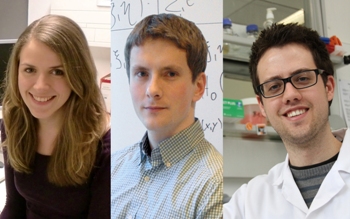Jun 11 2013
Three young researchers have been recognized for producing final dissertations that demonstrate scientific excellence. Their findings include new methods of naturally preserving fresh foods with hops extracts, an ultra-compact microscope that makes it possible to examine hundreds of prepared samples simultaneously, and the use of protein-protein interaction analysis to nip fungal pathogens in the bud.
 The Hugo -Geiger prize winners: Andrea Hickisch, René Berlich and Yannick Bantel. © Dirk Mahler/Fraunhofer
The Hugo -Geiger prize winners: Andrea Hickisch, René Berlich and Yannick Bantel. © Dirk Mahler/Fraunhofer
Three talented young scientists have been awarded the Hugo Geiger Prize for their outstanding research findings: First place has gone to Andrea Hickisch, who has come up with new ways of naturally preserving fresh foods with hops extracts.
René Berlich’s ultra-compact microscope has made it possible to examine hundreds of prepared samples simultaneously. Thanks to the microscope‘s integrated lighting, even non-transparent specimens are easily studied.
Third prize has been awarded to Yannick Bantel, whose research has nipped fungal pathogens in the bud: his protein-protein interaction analysis provides an important basis for the development of potential remedies.
Hops extracts as a natural preservative
From colorful salads to bite-sized pieces of fruit: while fresh ready-to-eat foods are healthy and in high demand, they also spoil easily. In the course of her diploma thesis, Andrea Hickisch of the Fraunhofer Institute for Process Engineering and Packaging IVV exploited the antibacterial effect of hops extracts to make fresh foods “naturally” preservable and safe.
Our nutrition is important to us: on lunch breaks, we like to eat fruits, vegetables, or meals that have been prepared in a healthy manner. The food industry has responded to this trend by offering ready-to-eat foods at every supermarket, such as sliced fruits, salads or meals with fish or meat. But such fresh and minimally processed products present a problem: they spoil easily. And since consumers tend to eat these foods raw or briefly heated, they can pose a health risk.
A young researcher at the Fraunhofer Institute for Process Engineering and Packaging IVV has now found a way to significantly minimize the microbiological risk in the production of fresh and minimally processed foods. As she describes in her diploma thesis, natural hops extracts are a promising alternative to conventional preservatives.
In Europe, we have known that hops preserve beverages since the Middle Ages, and the substance is still used in beer production today. But as Andrea Hickisch has proven, hops are capable of a great deal more. She examined the effects of natural hops extracts on the bacteria and pathogens that spoil different foods.
The results of her research showed that hops open up new ways of providing consumers with naturally preserved fresh foods. Whether they are added to packaging or placed directly on products, hops have an antibacterial effect. The experiments of Andrea Hickisch are likely to have far-reaching consequences for the food industry. After all, consumers of healthy foods are generally critical of synthetic preservatives.
Ultra-compact fluorescence microscope
While insect eyes may appear strange to us because of their small size, insects see a great deal, and their vision is truly multifaceted. In technical terms, an insect‘s eye is equipped with several lenses arranged next to each other. Each of these lenses transmits individual parts of an image. Taken together, they make up a full view. Thanks to their compact build, micro-optical systems based on this idea provide fascinating new possibilities and insights.
For his master‘s thesis, René Berlich (M. Sc.) of the Fraunhofer Institute for Applied Optics and Precision Engineering IOF not only developed an integrated illumination module for this microscope, which fits comfortably into any trouser pocket. He also enhanced the existing systems: thanks to his work, the microscope‘s resolution improved, and even smaller structures are now visible. For the first time, it can be used to examine fluorescence signals.
Compared with conventional fluorescence microscopes, which have only one imaging objective, the wide visual field makes it possible to investigate several samples at the same time without the need for sequential scanning. Examining hundreds of prepared samples simultaneously also saves time and money. This marks a significant step toward automating biomedical laboratory experiments.
Berlich‘s system offers a unique combination: cost-efficient manufacturing, a large image field, and an ultra flat design. With a distance of just 7 mm between the object and detector, the system is ideal for application in mobile medical analysis devices, for instance.